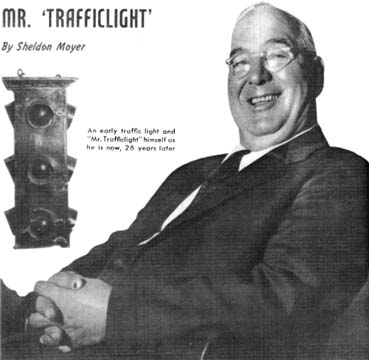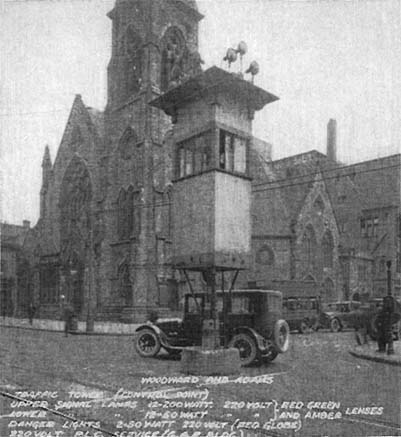
 |
It wasn't long after the inception of the automotive age that public officials realized power-driven vehicles soon would be "kissing" at the crossroads.
They were right, too, because the horseless carriages were no sooner out of the cradle stage when two of them would meet at the same point, and CRASH - just like two pedestrians coming around a blind corner and knocking noggins.
As a relief measure, the traffic "cop" was stationed in the center of the main avenue to separate the horses from the self-propelled carriages, and to keep them from crashing at the crossroads.
The scene soon became more complicated, however, and something had to be done. As automobiles became more prevalent, the "right-of-way" philosophy came into play, but some folks just couldn't tell the right from the left, and who should go first. So finally along came Mr. Trafficlight, the gentleman responsible for evolving our present-day system of traffic control.
Now there are days when you may feel like blaspheming the man who invented the traffic signal, especially when you're in a hurry and it turns red in your face. But for every such urging, there should be a kindly thought when the green light is staring in your direction.
Mr. Trafficlight is a half-grey, half-bald gentleman with a full-blown smile. He is William L. Potts, retired Detroit police inspector, who is now a traffic analyst for Automobile Club of Michigan. Potts is universally accepted as the originator of the first four-way traffic signal more than quarter of a century ago.
 |
| Woodward and E. Adams as it appeared in 1922 with tower |
The first four-way traffic signal tower in the world was located at the Woodward and Michigan Avenue intersection in October, 1920. The tower was manually operated and had 12 lamps, three in each direction. In December, 1920, signals were added along Woodward Avenue at Grand River, State, Fort and Congress, but all were controlled from the manual tower at Woodward and Michigan.
Then in 1921, Potts, who was Superintendent of Signals for the Police Department, installed his first automatic signal light system in 15 towers. During the next 25 years the location and operation of traffic lights throughout the world have changed considerably, but the original principle developed by Potts remains. The traffic tower in Detroit was removed from East Jefferson and Grand Boulevard in 1930. The traffic light system has been modernized with corner posts, hanging center lights and mast arm extensions.
Twenty-six years later there are more than 600 signalized intersections in Detroit with more than 11,000 lamps in service. Throughout the United States, the American Automobile Association reports, there are more than 36,000 signalized intersections.
According to Potts, the idea for red, green and amber lights was first used by railroads and his first automatic timing device at Woodward and Michigan was built from a sign flasher which cost $37.
"There was a definite growing need for traffic control, or as they say, 'Necessity is the mother of invention,'" Potts relates. "We couldn't coordinate men at different intersections with a manual system, but we could coordinate automatic electric signals."
Potts holds no patents on the device, but is generally regarded as its inventor. In 1924 the traffic signal device was being made commercially, and in 1928 a legal dispute arose between manufacturers. Finally the United States District Court of Appeals in Chicago handed down a decision in which Potts was credited with constructing and initiating the use of the first four-way traffic signal.
The first traffic lights had only four-inch lenses and the shell was wood with a tin cover. An original lamp was presented to Henry Ford's collection of Americana at the Edison Institute, Greenfield Village, in 1938.
 |
| The first signal tower with automatic lights, at Michigan and Woodward |
Potts retired from the police force in 1939 and joined the Safety and Traffic Department at Automobile Club of Michigan. Here he is an expert on traffic surveys and signal problems that arise in Michigan cities. He also is acting chairman of the Detroit Safety and Traffic Committee sponsored by Auto Club. The committee, a clearing house consisting of local, county and state police and road officials, meets every Wednesday noon at the Detroit-Leland Hotel to thrash out traffic problems.
This is also the twenty-sixth anniversary of the first police radio call car in Detroit. Potts equipped the first police car with an experimental radio set in 1921. By 1923 a regular unit was in operation, but the police had to broadcast music in between official instructions to comply with Federal regulations of the time.
Since that early day both traffic control and two-way radio systems have come a long way, thanks to the pioneering efforts of men like Mr. Trafficlight.